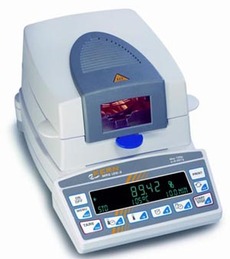
Using a Moisture Analyzer for Wheat Quality Control
Moisture content, defined as the percentage of a product’s weight attributed to water, is a critical quality control parameter across numerous industries. In agriculture, particularly with grains like wheat, precise moisture measurement is essential for storage, processing, and ensuring product longevity. A gravimetric moisture analyzer plays a pivotal role in these processes, providing accurate and rapid assessments that comply with industry regulations. In this post, we provide an overview of using a moisture analyzer for wheat quality control.
The Importance of Moisture Control in Wheat and Flour

Agricultural products, such as grains and the flour derived from them, exemplify the vital role of moisture analyzers. For instance, according to a University of Minnesota Extension Report, wheat and barley grain require a moisture content between 13% and 14% for safe storage. Exceeding this range can lead to mold growth, spoilage, and significant economic losses. Achieving this target, especially during wet weather, can be challenging, requiring careful monitoring and drying processes.
Similarly, when wheat is milled into flour, moisture content remains a critical factor. A study from the Institute of Food Science and Technology, University of Agriculture, Faisalabad, Pakistan, highlights the direct correlation between flour moisture content and shelf life. Lowering the flour moisture content enhances its storage stability. The study concluded that flour with a moisture content between 9% and 10% is optimal for extended shelf life, preventing clumping, mold, and other forms of deterioration.
Utilizing a Moisture Analyzer for Wheat Quality Control
Desk- or table-top moisture analyzers, such as the IL Series available from Tovatech, are ideal for small-sample validation of grain and flour moisture content. These devices function as miniature halogen-heated “ovens” integrated with a microprocessor-controlled analytical balance, offering precise and efficient measurements.
Step-by-Step Guide to Using a Moisture Analyzer:
- Sample Preparation:
- Load a representative sample of grain or flour onto the sample pan.
- Ensure the sample is evenly distributed across the pan’s surface to promote uniform heating. This step is critical for accurate results.
- Programming the Analyzer:
- Program the target moisture content or drying time into the precision scale according to the manufacturer’s instructions.
- For wheat grain, aim for 13-14% moisture.
- For wheat flour, aim for 9-10% moisture.
- Initiating the Drying Process:
- Activate the moisture analyzer.
- The halogen lamps will distribute rapid and even heat across the sample, driving off moisture.
- Monitoring the Drying Process:
- The analyzer will continue heating until one of the following occurs:
- The weight of the sample becomes constant, indicating no further moisture loss.
- A pre-set drying time is reached.
- The rate of weight loss per unit of time falls below a target value.
- The analyzer will continue heating until one of the following occurs:
- Analyzing the Results:
- The moisture analyzer will compute and display the sample’s moisture content.
- Record the results for quality control and compliance purposes.
- Data Management:
- For adherence to Good Laboratory Practice (GLP) standards, connect the moisture analyzer to a PC and statistics printer via an RS-232 interface. This allows for detailed record-keeping and data analysis.
Benefits of Using a Moisture Analyzer in Wheat Processing:
- Improved Storage Stability: Accurately controlling moisture content prevents spoilage and extends the shelf life of wheat and flour.
- Enhanced Processing Efficiency: Optimal moisture levels ensure efficient milling and processing, reducing waste and downtime.
- Regulatory Compliance: Consistent moisture measurements help meet industry standards and regulatory requirements.
- Economic Advantages: Preventing excess moisture reduces unnecessary weight, saving on transportation and storage costs.
- Quality Assurance: Regular moisture checks guarantee consistent product quality and customer satisfaction.
Beyond Wheat: The Versatility of Moisture Analyzers
Grains and flours are just two examples of food categories where precise moisture control is essential. Excess moisture can impair food processing efficiency, lead to spoilage, and result in customers paying for unnecessary weight. Conversely, overly dry products can also hinder processing. A moisture analyzer is a valuable investment for regularly monitoring the moisture content of various food products, following your company’s operations manual.
Optimizing Your Wheat Quality Control
By implementing a moisture analyzer into your wheat processing workflow, you can ensure consistent quality, improve efficiency, and enhance customer satisfaction. For expert guidance on selecting and using a moisture analyzer for your specific needs, call or chat with the experts at Tovatech.
